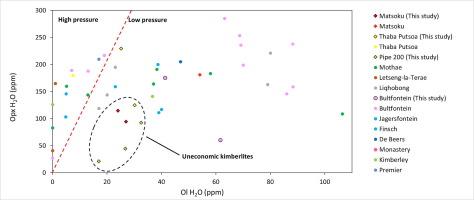Heterogeneous water distribution in between peridotite xenoliths from Kaapvaal Craton kimberlites: Constraints on diamond barren nature of kimberlites
IF 7.2
1区 地球科学
Q1 GEOSCIENCES, MULTIDISCIPLINARY
引用次数: 0
Abstract
Nominally anhydrous mantle minerals (olivine, pyroxenes, garnets, etc.) in 11 peridotite xenoliths from four different uneconomic and economic Kaapvaal Craton kimberlite pipes (Matsoku, Thaba Putsoa, Pipe 200 and Bultfontein) have been investigated using Fourier transform infrared spectroscopy (FTIR). All xenoliths contain accessories of garnet, diopside, chromite, and phlogopite. High orthopyroxene content (>30 mol vol.%) in most xenoliths from all kimberlites and its interconnected channel-like nature hint towards hydrous siliceous fluid metasomatism. Peridotite xenoliths from uneconomic kimberlites show development of phlogopite and clinopyroxene (± chromite) forming veins and in garnet rims suggesting metasomatism by alkaline silico-carbonatite (possibly kimberlite-related) melt. The xenoliths contain significant H2O in olivine (17–62 ppm), orthopyroxene (21–230 ppm), and clinopyroxene (87–833 ppm), whereas garnets are dry and only show IR absorbance bands at > 3,670 cm−1 for contamination of hydrous minerals. Compared to the economic kimberlites in the Kaapvaal Craton, the uneconomic kimberlite xenoliths from this study have lower orthopyroxene and olivine H2O content. In the xenoliths affected by garnet breakdown metasomatism, the H2O content of orthopyroxene and olivine is higher and lower, respectively. The structural hydroxyl distribution profile across olivine and higher inter-mineral water partition coefficient, suggest diffusion of hydrogen and possible re-equilibration. Statistical analysis of the olivine spectra suggests that hydrogen bands at 3540, 3624, 3638, and 3672 cm−1 are a good discriminant of economic and uneconomic kimberlites and in literature, they are associated with metasomatism, weathering-associated processes, high water activity, and oxygen fugacity. The lower water concentration in xenoliths from uneconomic kimberlite from the margin of the craton than the economic kimberlites from the interior of the Kaapvaal Craton and identified metasomatism hints towards dehydration of xenoliths by water-poor and CO2-rich melts in tectonized cross-lithospheric zones causing diamond resorption and may be responsible for the diamond-poor nature of uneconomic kimberlites in northern Lesotho.

卡普瓦尔克拉通金伯利岩橄榄石间的异质水分布:金伯利岩金刚石贫瘠性质的制约因素
采用傅立叶变换红外光谱法(FTIR)对来自四个不同的非经济和经济卡普瓦尔克拉顿金伯利岩管道(Matsoku、Thaba Putsoa、Pipe 200 和 Bultfontein)的 11 块橄榄岩异长岩中的标称无水地幔矿物(橄榄石、辉石、石榴石等)进行了研究。所有独居石都含有石榴石、透辉石、铬铁矿和辉绿岩。来自所有金伯利岩的大多数闪长岩中的正长石含量较高(30 mol vol.%),其相互连接的通道状性质暗示了水硅质流体变质作用。来自非经济金伯利岩的橄榄石闪长岩显示出辉绿岩和霞石(±铬铁矿)形成的矿脉以及石榴石边缘的发育,这表明是碱性硅碳酸盐岩(可能与金伯利岩有关)熔体的变质作用。橄榄石(17-62 ppm)、正长石(21-230 ppm)和菱镁矿(87-833 ppm)中的析出物含有大量的 H2O,而石榴石是干燥的,仅在 > 3,670 cm-1 处显示出红外吸光度带,表明受到含水矿物的污染。与卡普瓦尔克拉通的经济金伯利岩相比,本研究中的非经济金伯利岩的正长石和橄榄石 H2O 含量较低。在受石榴石击穿变质作用影响的闪长岩中,正长石和橄榄石的 H2O 含量分别较高和较低。橄榄石的羟基结构分布图和较高的矿物间水分配系数表明氢的扩散和可能的再平衡。橄榄石光谱的统计分析表明,3540、3624、3638 和 3672 cm-1 处的氢带可以很好地区分经济金伯利岩和非经济金伯利岩。与来自卡普瓦尔克拉通内部的经济金伯利岩相比,来自克拉通边缘的非经济金伯利岩的析出物中的水浓度较低,而且已查明存在变质作用,这表明在构造化的跨岩石圈地带,贫水和富含二氧化碳的熔体使析出物脱水,导致金刚石重吸收,这可能是莱索托北部非经济金伯利岩贫乏金刚石的原因。
本文章由计算机程序翻译,如有差异,请以英文原文为准。
求助全文
约1分钟内获得全文
求助全文
来源期刊

Gondwana Research
地学-地球科学综合
CiteScore
12.90
自引率
6.60%
发文量
298
审稿时长
65 days
期刊介绍:
Gondwana Research (GR) is an International Journal aimed to promote high quality research publications on all topics related to solid Earth, particularly with reference to the origin and evolution of continents, continental assemblies and their resources. GR is an "all earth science" journal with no restrictions on geological time, terrane or theme and covers a wide spectrum of topics in geosciences such as geology, geomorphology, palaeontology, structure, petrology, geochemistry, stable isotopes, geochronology, economic geology, exploration geology, engineering geology, geophysics, and environmental geology among other themes, and provides an appropriate forum to integrate studies from different disciplines and different terrains. In addition to regular articles and thematic issues, the journal invites high profile state-of-the-art reviews on thrust area topics for its column, ''GR FOCUS''. Focus articles include short biographies and photographs of the authors. Short articles (within ten printed pages) for rapid publication reporting important discoveries or innovative models of global interest will be considered under the category ''GR LETTERS''.
 求助内容:
求助内容: 应助结果提醒方式:
应助结果提醒方式:


